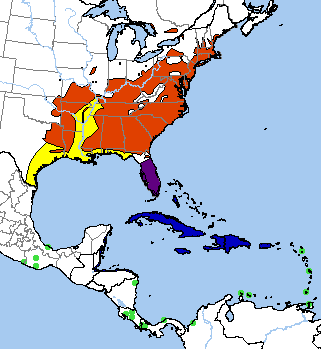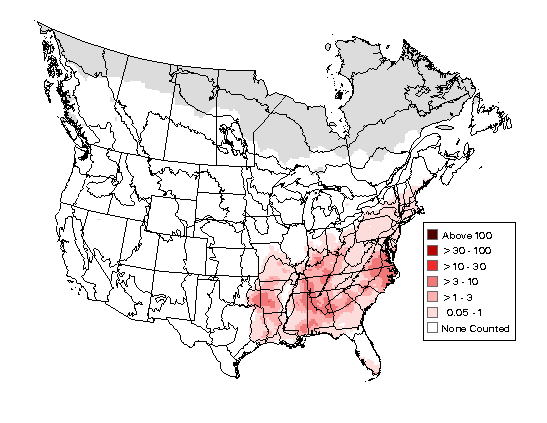Birdfinding.info ⇒ A common breeder in its preferred habitat across much of the eastern U.S. (see Breeding Bird Survey Abundance Map in Notes, below). Very common as a migrant in Florida and fairly common in winter in southern Florida, the Bahamas, and the Greater Antilles.
Prairie Warbler
Setophaga discolor
Breeds in the eastern U.S. and southeastern Canada. Winters in Florida and the West Indies.
Breeding. Semiopen, usually grassy or weedy areas with scattered shrubs, patches of brush, or short trees, across much of the eastern U.S. north to Illinois, Michigan, southern Ontario, and southern Maine, south to northern Florida, west to eastern Texas and Oklahoma. Also in mangrove swamps and scrub in peninsular Florida.
Nonbreeding. Winters in mangroves, dry forests, and scrub throughout most of Florida and the West Indies east to the Virgin Islands, and along the Caribbean coast of the Yucatán Peninsula and adjacent islands south the Honduran Bay Islands. Rare or casual winter visitor east to Guadeloupe, west to California, and south to Panama.
Movements. Most migration is through Florida. From spring into fall, sometimes strays west and north of its breeding grounds: e.g., Colorado, Minnesota, Quebec, and Nova Scotia.
Identification
A bright yellow-and-olive warbler with a distinctive facial pattern: a yellow face with a black eyeline joined with a black crescent on the cheek. Also has black or blackish streaks on its sides from the neck to the flanks.
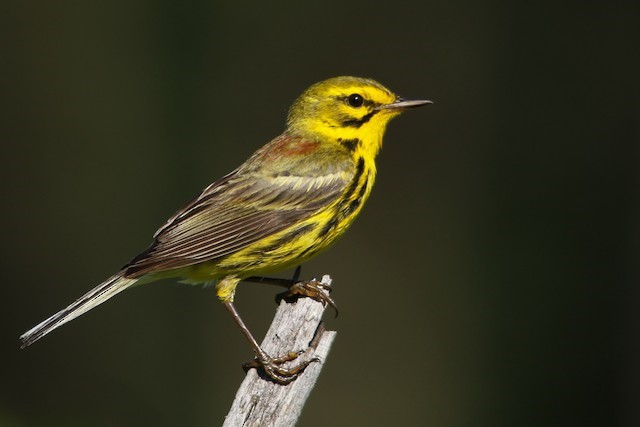
Prairie Warbler. (Soldiers Delight Natural Environment Area, Maryland; June 24, 2018.) © Kojo Baidoo
On adult males the colors are vivid and the pattern is bold and contrasty. Adult males also have rich chestnut streaks on the upper back.
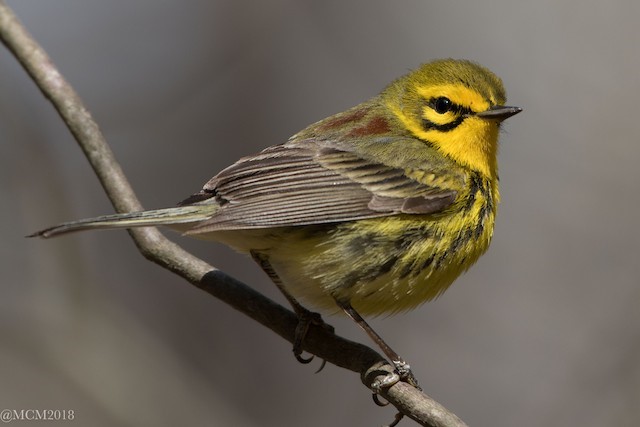
Prairie Warbler, male. (First Landing State Park, Virginia; April 5, 2018.) © Mary Catherine Miguez
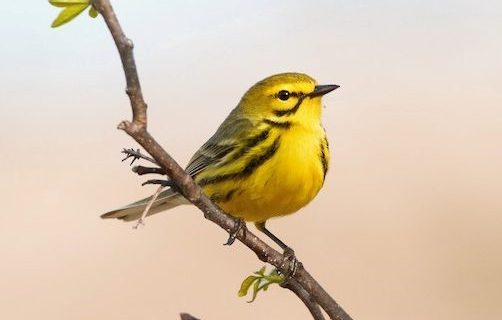
Prairie Warbler, male. (Warren Dunes State Park, Michigan; May 6, 2016.) © Nathan DeBruine

Prairie Warbler, male showing white pattern on inner webs of tail feathers. (Bethel Bike Trails, De Soto National Forest, Mississippi; April 2, 2017.) © Holly Cox
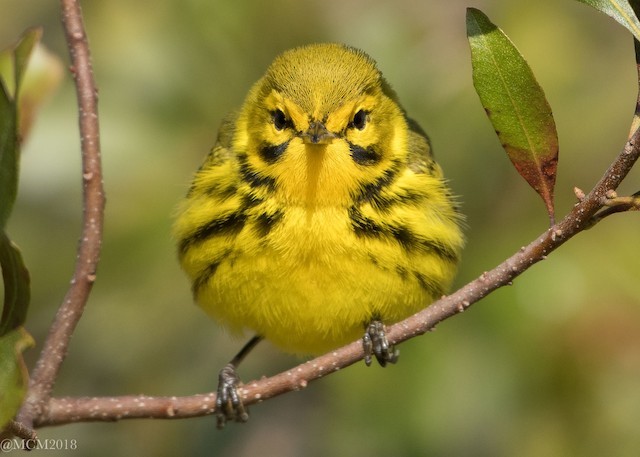
Prairie Warbler, male, full-frontal. (Virginia Beach, Virginia; March 31, 2018.) © Mary Catherine Miguez
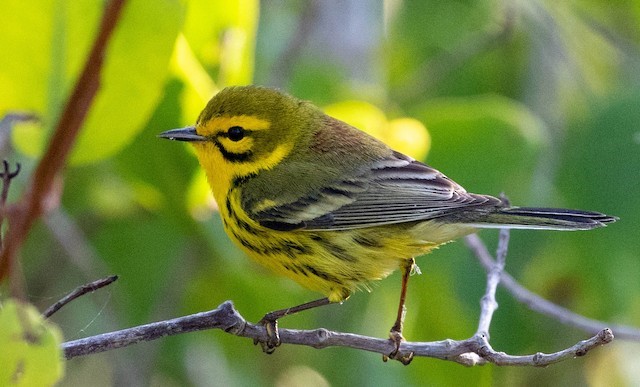
Prairie Warbler, male. (Cayo Coco, Ciego de Ávila, Cuba; March 22, 2018.) © Mel Senac
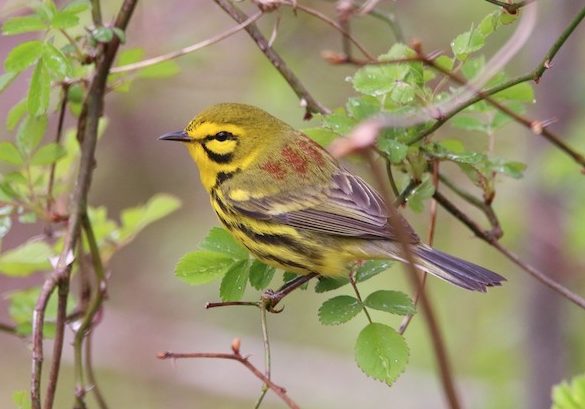
Prairie Warbler, male. (Cape May, New Jersey; April 19, 2018.) © Devin Griffiths
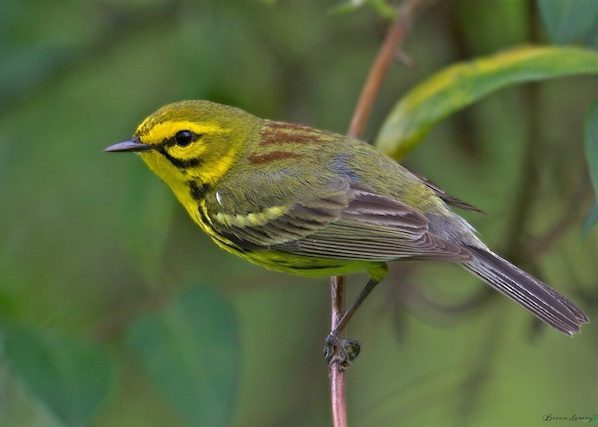
Prairie Warbler, male. (Meadow Glen Farm, Leota, Indiana; April 30, 2017.) © Brian Lowry

Prairie Warbler, male. (Alligator River National Wildlife Refuge, North Carolina; April 5, 2018.) © Corey Finger
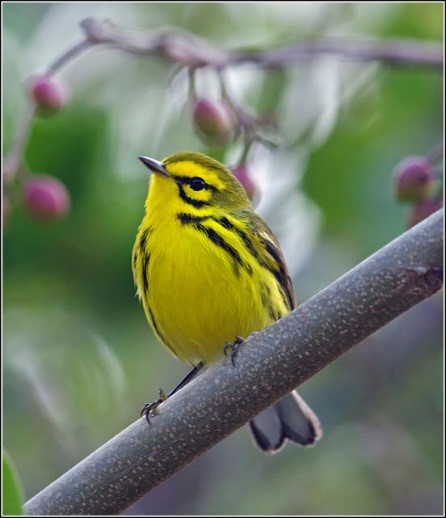
Prairie Warbler, male. (Cayo Santa María, Cuba; February 22, 2015.) © Joshua D. Vandermeulen
On adult females the pattern is less distinct than on males, the yellow is less vivid, and the markings on the face and sides can be either blackish or dark olive.
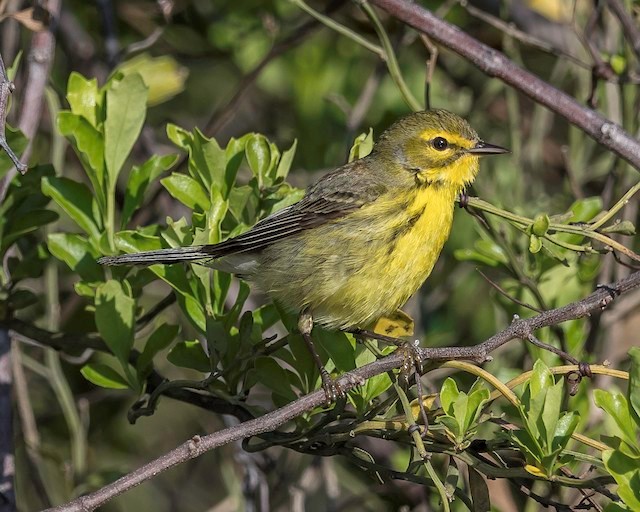
Prairie Warbler, female. (Markham Park, Sunrise, Florida; March 21, 2017.) © David Hall
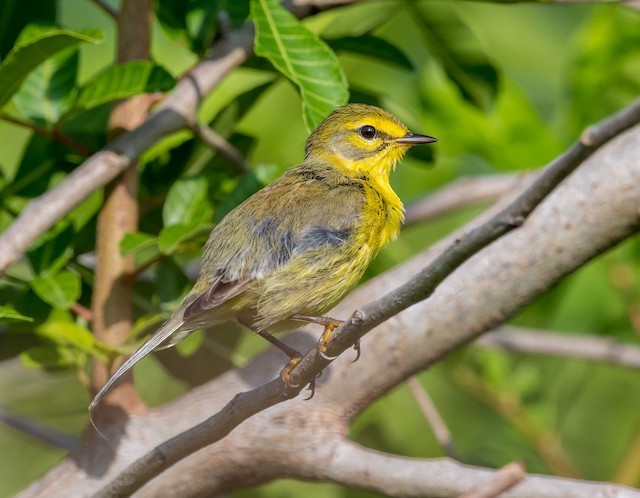
Prairie Warbler, female. (Markham Park, Sunrise, Florida; April 8, 2018.) © David Hall

Prairie Warbler, female. (Ancón Peninsula, Cuba; February 17, 2015.) © Joshua D. Vandermeulen

Prairie Warbler, female. (Abaco National Park, Bahamas; December 10, 2015.) © Jason Estep
Immatures have the same pattern as adults, muted as in adult females, but with gray cheeks and usually white crescents above and below the eyes.
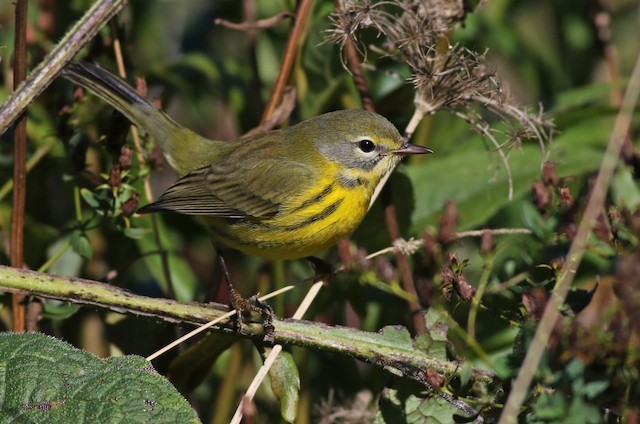
Prairie Warbler, immature. (Monhegan Island, Maine; October 5, 2018.) © Jeremiah Trimble
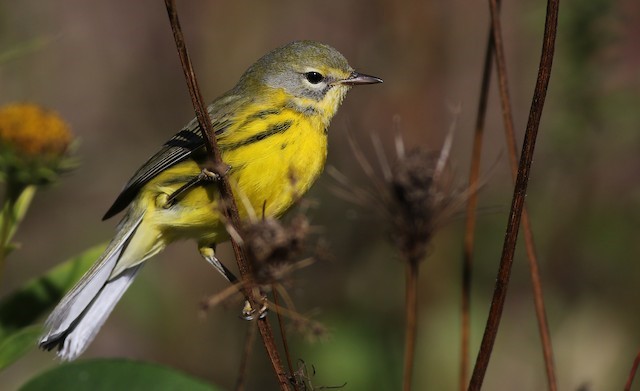
Prairie Warbler, immature. (Monhegan Island, Maine; October 5, 2018.) © Jeremiah Trimble
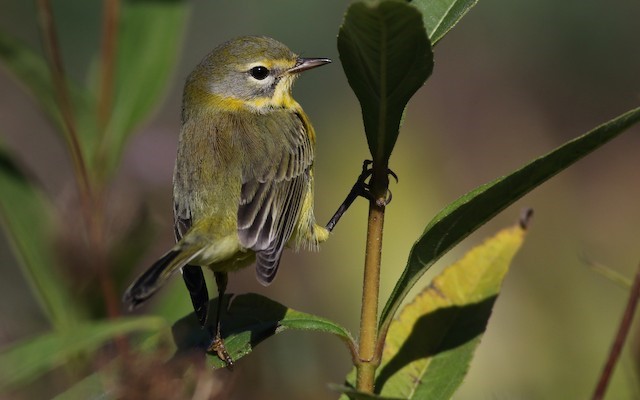
Prairie Warbler, immature. (Monhegan Island, Maine; October 5, 2018.) © Jeremiah Trimble
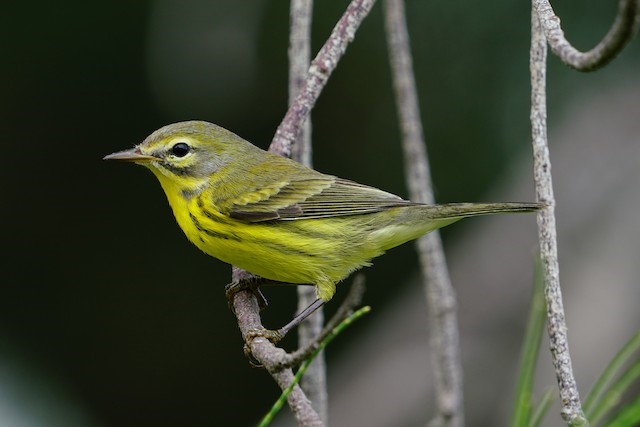
Prairie Warbler, immature. (Ferry Point Park, Bermuda; September 8, 2018.) © Erich and Janice Hetzel
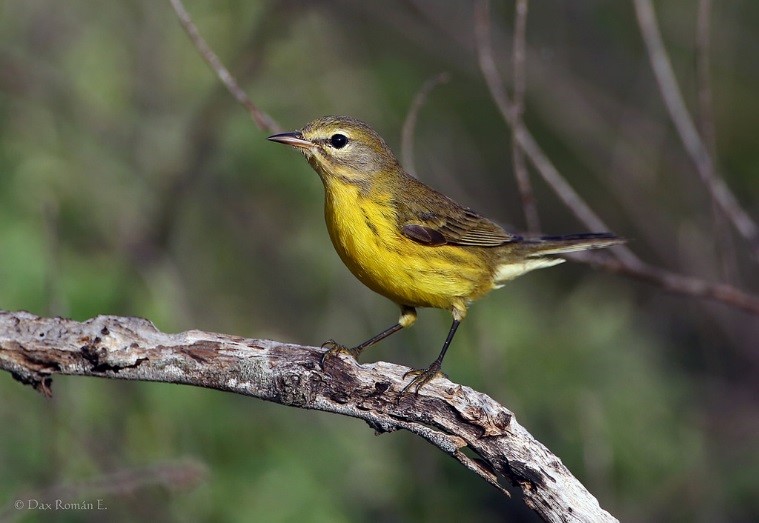
Prairie Warbler, immature. (Salinas de Baní, Dominican Republic; September 13, 2014.) © Dax M. Román E.
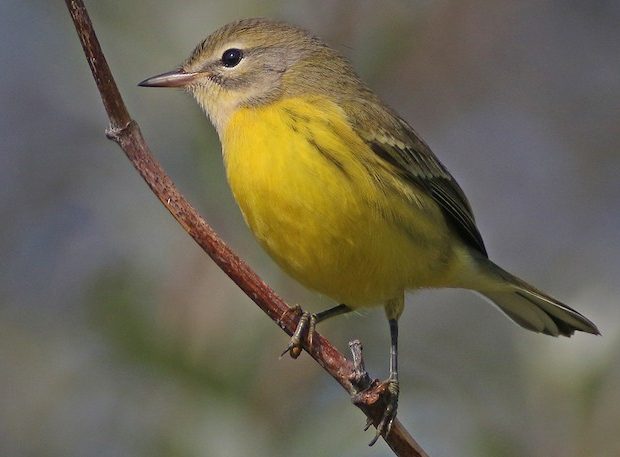
Prairie Warbler, immature. (Rockaway Beach, Queens, New York; September 11, 2017.) © Corey Finger
Cf. Immature Magnolia Warbler. Immature Prairie Warblers typically have a muted facial pattern with all-gray cheeks, and are readily confused with immature Magnolia Warblers. Magnolia differs most conspicuously in having a yellow rump.
Cf. Vitelline Warbler. In the Cayman and Swan Islands of the western Caribbean, Vitelline Warbler closely resembles the female Prairie Warbler, but has yellower upperparts, brighter wingbars, and more limited and indistinct streaks on the sides.
Notes
Polytypic species consisting of two recognized subspecies.
References
Alderfer, J., and J.L. Dunn. 2014. National Geographic Complete Birds of North America (Second Edition). National Geographic Society, Washington, D.C.
Dunn, J.L., and K.L. Garrett. 1997. A Field Guide to Warblers of North America. Houghton Mifflin, Boston.
eBird. 2018. eBird: An online database of bird distribution and abundance. Cornell Lab of Ornithology, Ithaca, N.Y. http://www.ebird.org. (Accessed November 25, 2018.)
Fagan, J., and O. Komar. 2016. Peterson Field Guide to the Birds of Northern Central America. Houghton Mifflin Harcourt, New York.
Garrido, O.H, and A. Kirkconnell. 2000. Field Guide to the Birds of Cuba. Cornell University Press, Ithaca, N.Y.
Haynes-Sutton, A., A. Downer, R. Sutton, and Y.-J. Rey-Millet. 2009. A Photographic Guide to the Birds of Jamaica. Princeton University Press, Princeton, N.J.
Howell, S.N.G., and S. Webb. 1995. A Guide to the Birds of Mexico and Northern Central America. Oxford University Press, Oxford.
Latta, S., C. Rimmer, A. Keith, J. Wiley, H. Raffaele, K. McFarland, and E. Fernandez. 2006. Birds of the Dominican Republic and Haiti. Princeton University Press, Princeton, N.J.
Raffaele, H., J. Wiley, O. Garrido, A. Keith, and J. Raffaele. 1998. A Guide to the Birds of the West Indies. Princeton University Press, Princeton, N.J.
Ridgely, R.S., and J.A. Gwynne. 1989. A Guide to the Birds of Panama (Second Edition). Princeton University Press, Princeton, N.J.

